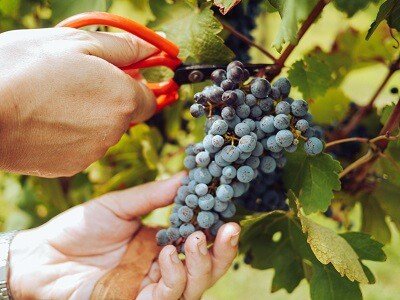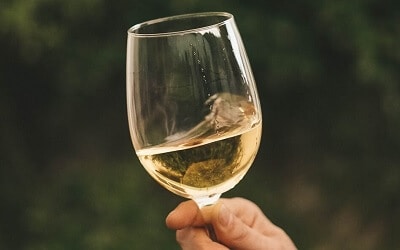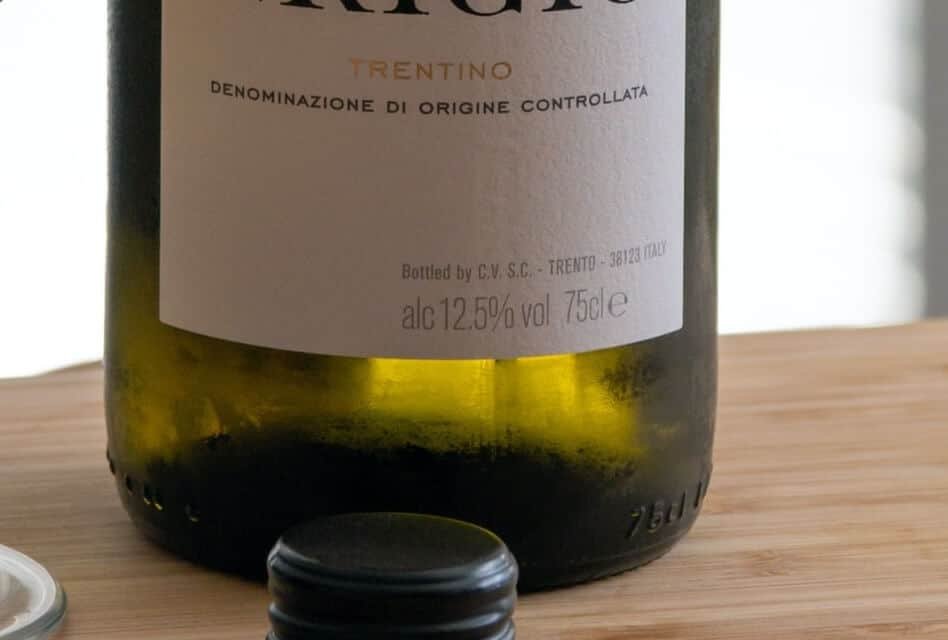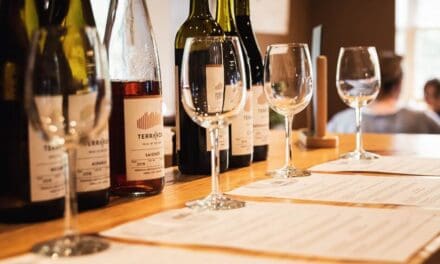Just like in beer, vodka, whisky, or other spirits, there is alcohol in wine. While many people enjoy its effect, they do not know that it occurs naturally during the winemaking process. And even more important, it serves various crucial purposes. Without alcohol, wine would not be the same. But how much alcohol is in wine, and how can vintners impact the amount of alcohol in wine?
The average volume of alcohol in wine is between 11 and 15%. However, it can be significantly higher or lower, depending on the production processes. Fortified wines typically have up to 20%, while sparkling wines can have less than 6% alcohol.
The alcohol content depends on numerous factors, such as the grape variety. And vintners have various options to alter the alcohol level in their wines. In this article, we will discuss the details.
WHY IS THERE ALCOHOL IN WINE?
Alcohol in wine is the result of fermentation. Fermentation is a chemical process that happens shortly after the harvest, and it’s a crucial part of winemaking.
First, winemakers crush the grapes to release their juice. This juice that sometimes still contains solids such as skins, stems, and seeds is called “wine must”. Next, the winemakers add yeast to the must to start the fermentation. Yeast is a specific type of single-cell fungus. It feeds on the sugar that naturally exists in grapes and transforms it into carbon dioxide and alcohol. More specifically, it produces ethanol, also known as ethyl alcohol.
In this regard, winemaking is somewhat similar to beer brewing. Without fermentation, there would neither be alcohol in wine nor beer. Fermentation also occurs when you make dough for bread. But in this case, only a minimal amount of alcohol is created, and it evaporates before the bread makes its way into the oven. Thus, it does not play a significant role.
Growing and Harvesting Grapes
The amount of alcohol in wine depends primarily on the grapes that vintners choose for making their wines. Some varieties naturally contain more sugar than others. And more sugar means more alcohol at the end of the fermentation process.
By scheduling the harvest, winemakers can further alter the grapes’ sugar level. The earlier the harvest, the less sugar the berries accumulate and the less alcohol the final wine will contain. That is the case for many white wines. The grapes for these wines often are harvested in late July or early August (in Northern Hemisphere countries). In contrast, the harvest of red grapes happens in September, October, or even later. By that time, the grapes contain much more sugar that can be turned into alcohol.

Wine Grape Harvest
Wine Fortification
Fortified wines are a special category of wines with very high alcohol volumes. That is because vintners increase the alcohol level artificially. More specifically, they terminate the fermentation process early by adding a neutral spirit such as Brandy to the wine must. This spirit kills the yeast cells, so they cannot continue to transform sugar into alcohol. This process is called fortification.
Historically, fortification was used to preserve wine and prevent it from spoiling during long journeys. Today, there are more sophisticated means of preservation. However, many vintners stick to this traditional method when producing dessert wines. By stopping the fermentation early, they ensure that a lot of residual sugar is left in the wine must. Thus, the final wine is deliciously sweet, in some cases, even comparable to soft drinks.
Examples of these sweet fortified wines are Port, Madeira, Sherry, Vermouth, Marsala, and Commandaria.
HOW DOES ALCOHOL AFFECT WINE?
Alcohol in wine has effects on the shelf-life, taste, and balance.
One of the most important is preservation. Alcohol prologues a wine’s shelf life significantly. High-alcohol fortified wines are almost immune to spoilage and can last hundreds of years.
But alcohol also affects the taste of wine. It adds texture and makes the wine more viscous. High-alcohol wines can be very dense and almost syrup-like, while low-alcohol wines tend to be thin and watery.
Wine lovers refer to this characteristic as wine body. So when you hear about a wine’s body, you can draw conclusions about its alcohol content:
- light-bodied wines usually have less than 12.5% alcohol
- medium-bodied wines have between 12.5 and 13.5%
- full-bodied wines have more than 13.5% vol.
Besides adding viscosity, alcohol in wine helps balance its other characteristics like acidity, sweetness, and tannins. For instance, it makes aggressive tannins less dominant. The same is true for acidity. Overall, alcohol creates a more harmonious drinking experience when it is well-balanced.
Too much alcohol can ruin the experience, though. When it overpowers other flavors, it might give the wine a hot, pungent taste that many people consider unpleasant.
CAN WINE BE ALCOHOL-FREE?
Technically it is possible to make alcohol-free wine. But from a legal point of view, wine must contain alcohol. Especially in countries with long winemaking traditions, such as France or Italy, laws require wines to be alcoholic. Without alcohol, producers cannot label them as wine. Instead, they use other names, such as “wine-based drink”. In the United States, they indicate the final alcohol level with additional labels:
- “low-alcohol” wines have a maximum of 1.2% alcohol
- “non-alcoholic” or “de-alcoholized” wines contain less than 0.5%
- “alcohol-free” wines have not more than 0.05% alcohol
Setting aside the legal regulations, it is technically possible to make alcohol-free wine. The winemaking process for these wines is similar to regular wine. They undergo common wine growing, harvesting, crushing, fermentation, and aging methods. But before bottling them, vintners remove the alcohol from their wines. To do so, they have several options.
Distillation
Vintners can put the wine in a vacuum and heat it. Because of the vacuum, it needs only relatively low temperatures of around 70 degrees Fahrenheit (21°C) to boil the wine. At these temperatures, the alcohol starts to evaporate, and the vintners can easily extract it.
Unfortunately, this distillation process can cause delicate aromas to dissolve as well. If that happens, the alcohol-free wine turns out to be rather flat compared to regular wine. Thus, only a few winemakers use it.
Centrifugal Condensation
Alternatively, they can perform a process based on inverted cones. Vintners use them to spin the wine repeatedly at high speed. Due to the centrifugal forces during the spinning, the alcohol molecules are separated from the wine, so vintners can easily remove them.
Centrifugal condensation does not affect the taste of wine as significantly as distillation. But it requires some costly high-tech equipment.
Reverse Osmosis
The third way to extract and reduce the level of alcohol in the wine is called “reverse osmosis“: Vintners expose the wine to very high pressure and force it against a fine membrane. Only water and alcohol particles can pass this membrane, so the remaining wine becomes a concentrate. After removing the alcohol, the winemakers add the water back to the concentrate and finalize the alcohol-free wine. Usually, they have to perform this process multiple times to minimize the alcohol level.
Reverse osmosis has two advantages: First, it preserves the wine’s aromas. And second, it does not require expensive equipment. For these reasons, it’s the preferred method of many vintners who want to produce low-alcohol wine.
DOES ALCOHOL CONTENT IN WINE EVAPORATE?
As long as the cork (or the bottle cap) seals the bottle, the level of alcohol in wine stays unchanged. Only when the bottle is opened, and the wine gets in contact with air, the alcohol will start evaporating.
Evaporation happens at a slow rate, though. Even if you allow the wine to stay in touch with oxygen for days, its alcohol content will not decrease significantly.
Nevertheless, the drinking experience changes perceivably. That is because aeration helps the wine “open up”, so its most delicate aromas can shine. As a result, strong alcoholic odors become less dominant.

Man Swirling Wine to Aerate It
DOES ALCOHOL CONTENT IN WINE INCREASE WITH AGE?
The level of alcohol in wine is determined during the production process, primarily during fermentation. After bottling, it does not change anymore. Even if you store it for decades, it will not get stronger or lighter.
Other aspects of its flavor profile might change, though. High-quality wines develop new, more delicate aromas, and their tannins become less aggressive. These changes can alter the perception of alcohol, resulting in a more balanced, better wine.
WHAT IS THE AVERAGE ALCOHOL CONTENT OF WINE?
Alcohol contents can vary significantly depending on the type of wine. In many countries, wine laws regulate minimum and maximum contents. For instance, European Union regulations limit the content of alcohol in wine to 15% in general. Some exceptions of up to 20% for wines from specific regions are allowed, though.
Let us have a look at the average alcohol contents of the different types of wine.
Alcohol Content in White Wine
Most white wines are low to medium in alcohol. One reason for this fact is that vintners usually harvest white grapes relatively early in the year. Thus, they do not have much time to accumulate sugar that can be converted into alcohol later. These are the average alcohol levels for popular white wines:
- Riesling, Vinho Verde, Vouvray, Muscadet: less than 12.5%
- Pinot Grigio, Sauvignon Blanc, Albarino, Grüner Veltliner, White Burgundy, White Bordeaux: 12.5 – 13.5%
- Chardonnay, Sauternes: 13.5 – 14.5%
Alcohol Content in Red Wine
Grapes for red wine stay on the vines longer than white wine grapes. As they have more time to ripen, they can accumulate more sugar that vintners can turn into alcohol during fermentation. Logically, red wines tend to be higher in alcohol than whites. Most have medium to high alcohol levels, for example:
- Beaujolais, Red Burgundy, Red Bordeaux, Chianti, Rioja: 12.5 – 13.5%
- Shiraz, Barolo, Pinot Noir: 13.5 – 14.5%
- Malbec, Cabernet Sauvignon: 13.5 – 15%
- Zinfandel, Petit Sirah: 14 – 18%
Alcohol Content in Fortified Wines
The highest levels of alcohol in wine can be found in fortified wines. Most of them have at least 15%, and many can contain up to 20%. Accordingly, they belong to the category of full-bodied wines. These are the most famous fortified wines:
- Commandaria: 10 – 20%, commonly around 15%
- Dubonnet: 15% (French Dubonnet) to 19% (American Dubonnet)
- Lillet: around 17%
- Port Wine: around 20%
- Madeira Wine: 18 – 22%
- Marsala: 15 – 20%
- Vermouth: 16 – 22%
Alcohol Content in Sparkling Wines
Sparkling wines tend to be light-bodied. Most have between 9 and 13% alcohol, but some are even lower in alcohol, especially when they’re sweet. Here are the alcohol contents for famous sparkling wines:
- Champagne: around 12%
- Prosecco: 11 – 12%
- Cava: 10.5 – 12.8%
- Sekt: 10 – 13%
- Asti: 6 – 9%
- Moscato d’Asti: 5 – 6%
- Lambrusco: around 8%
- Brachetto: around 5%
- Franciacorta: 11.5 – 15%
FINAL WORDS
Alcohol in wine is essential, and it has many more purposes than making drinkers tipsy. It helps create a well-balanced, harmonious beverage and also preserves it from spoiling. With these facts at hand, you might want to try wines that you rejected before for their high alcohol volumes. They might be stronger, but they offer uniquely delicious flavors that are worth trying in many cases.






